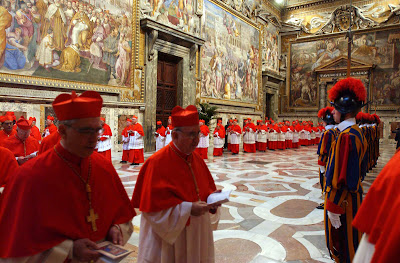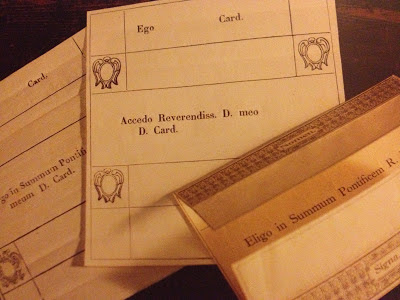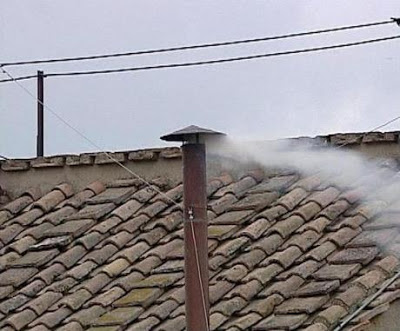 |
| © AP/Alessandra Tarantino [source] |
This post has been about a year in the making. I meant to write it right after Pope Francis was elected one year ago today, in order to share with you, my dear bloglings, what I experienced that unforgettable night. Honestly, I did.
But the truth is, I was so sick and tired (mostly tired) of blogging by that point that I just couldn't face it. I kept putting it off and putting it off, until the papal election wasn't news anymore and there didn't seem any reason to write about it. But now everyone's favorite pope's first anniversary is here, and I finally have an excuse to write that post I've been meaning to write for so long.
Now, before we go any further, I don't want you to think that I'm still sick and tired of blogging. That was a temporary thing. You see, when dear old Benny (remember him?) decided he'd had it with the whole Supreme-Pontiff-of-the-Holy-Mother-Church/God's-Representative-on-Earth/Vicar-of-Christ/Must-always-Wear-White-no-Matter-the-Weather gig, I was swept up into a blogging (and tweeting) frenzy. As Rome moved toward conclave it got even worse. I ate, slept, and drank nothing but conclave. I became obsessed, my friends, obsessed. I even got added to the Huffington Post's list of conclave-related tweeps. That's how bad it got.
I'm sure you all know how long winded I am by now (case in point: this post), but my conclave-related blogposts defied all the rules of how long a post should reasonably be before you can assume your readers have given up and picked up War and Peace for some lighter reading. I blogged about Pope Celestine V, the only other pope who has willingly resigned, I blogged about the entire history of the papal conclave, which up till then had been my longest post ever, but then I topped myself just three days later when I blogged about every single minute (and probably useless) detail and rule of conclave that you have never wanted to know. What can I say, I was on a roll.
Then exhaustion hit. After spending something like 15 hours straight on that last post, I didn't even want to see my computer, let alone turn it on (and conclave hadn't even officially started yet!). But then I thought about Mozzarella Mamma. Big-time journalist, mother of three, she was running around the city, live tweeting from press conferences at the Vatican, interviewing the likes of Cardinal Timothy Dolan, and doing chimney watch from her perch atop Bernini's colonnade in St. Peter's Square, all the while baking red velvet cupcakes for her kids and hand-sewing them Carnival costumes. (OK, maybe I made that last bit up.) But still, I thought to myself, here is a woman with a crazy intense job, and three kids, and if she has the energy to blog about conclave every other night, surely I should have it to too.
So I eked out one last post on the first day of conclave, listing some of the most likely Papabili to take home the big prize. I left out our dear Frankie--just as the experts did--although I did predict an Argentinian, let it be noted! If the conclave had gone on for several days (or even weeks) as many people predicted, I don't know what I would have done. But as it happened, Pope Francis was elected the very next day, and afterwards I promptly collapsed and didn't post again for well over a month. Meanwhile Mozzarella Mamma posted a wrap-up just two days later--how does she do it???
Well, here, at long last, is mine. (Whoa, six paragraph preamble--I really need to learn the art of succinct blogging. Next time.)
Everyone knew the pope wouldn't be elected on the first day of conclave. With only two scrutinies, that would have been unprecedented. But most people didn't think he'd be elected the second day either. Unlike when Benny was up for election and a complete shoe-in, no one had any idea who'd be elected this time around, and we all assumed it would take at least three days. All I knew was, I wanted to be there when it happened.
I had missed the white smoke and first papal appearance back in 2005, and I wasn't going to miss it this time. Only problem was, I had tickets to the opera for the 3rd night of conclave, and I couldn't miss the chance of seeing Riccardo Muti conduct Verdi, especially as I had just interviewed him. If that hadn't been the case, I might not have gone to St. Peter's Square on the 13th at all, assuming it was too early anyway and planed to go the next night.
As it happened, I met my friend Jill (officially the most Catholic person I know) to take a leisurely stroll toward the Vatican around 5:30pm on Wednesday March 13th. Neither of us were expecting to see white smoke that night. When we arrived in the square, the atmosphere was jovial. Everyone was having a good time and no one could imagine the intense night that was ahead of them. Finally, at around 7pm, as we were milling about the back of the square, laughing with an American family we had just met, we noticed the smoke. At first it looked black, but nevertheless, just seeing the smoke was exciting, and everyone gasped gleefully. But then the smoke got grayer, and then it turned white. A collective whoop arose from the crowd as we realized we had a pope.
 |
| The very first sight of the smoke. It still looked gray at this point. © Tiffany Parks |
Instantly everyone began pressing forward, and I knew what I had to do. I grabbed my friend's hand and took off, fighting to get as close to the Benediction Loggia as possible. How many times in your life do you get to see a newly elected pope appear on that legendary balcony? Not many, and I wanted a front-row seat.
 |
| Can you see the tiny puff of white smoke behind me? |
Being short has its advantages, and I was able to push and dodge and squirm my way up nearly to the very front of the metal barricades until finally we could get no further. I dug out my phone and texted my maritino, telling him to high-tail it over here. Jill assured me we had at least 40 minutes before the new pope would be announced. Even so, my maritino ran. It was raining by this time and he just put his head down and ran. He described to me later the streets of the city, traffic stopped, just full of people running, all running toward the Vatican. I don't know how but he got there in 15 minutes (usually it's a 45 minute walk).
 |
| In the fray. White smoke clear as day. © Tiffany Parks |
Somehow in that crowd of tens of thousands of people, we managed to find each other. We also managed to secure a prime spot, just behind the statue of St. Peter (appropriate). The wait seemed eternal but at last we heard those historic words, "HABEMUS PAPAM." It gave me goosebumps, not because I am the world's biggest fan of the institution of the papacy, but because I knew I was witnessing a historic moment. When the name Bergolio was shouted, I was truly stumped. That wasn't one of the names I had painstakingly researched. The maritino was quicker, he shouted, "Argentino!" and I was happy just for that--without knowing anything about him--just that he was from South America. Just that was enough to make the election historic.
We were so caught up in the announcement of who the new pope was, we completely missed his papal name at first. Then we heard far-off voices, Roman voices, shouting "Francesco! Francesco! Francesco!" Could it be? we asked ourselves. It's not possible that he chose that name. Another first.
 |
| Pope Francis's first appearance. © Tiffany Parks |
But the moment no one who witnessed it could ever forget waswhen our new pope appeared. After the deafening cheers quieted, the newly minted pope stepped out onto the balcony and, with a humble smile, uttered the two words no one had expected, "Buona Sera." As if he were just talking to old friends. The entire square gasped and then exploded into even more cheers.
But surely the most moving moment was when he asked that, before he bless the crowd, (and give us all our hard-earned indulgences--no purgatory, yay!), that every person in the square should first bless him, and pray for him. He bowed his head with unimagined humility, and for a long moment that exuberant crowd of tens of thousands was absolutely silent and focused and reverent and it was powerful to be a part of.
 |
| I don't know how they managed to print this so fast. It was available before we left the square that night. © Tiffany Parks |






























